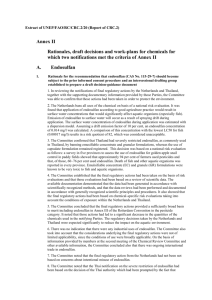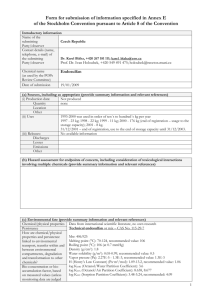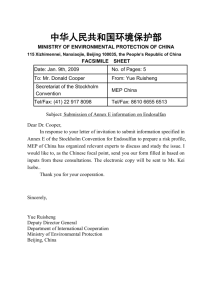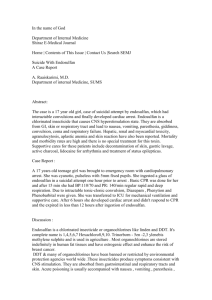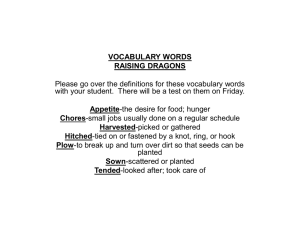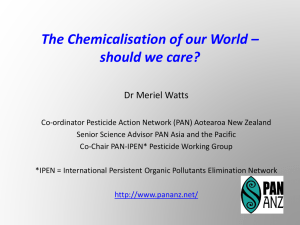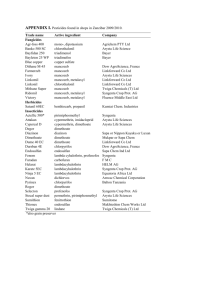African Boll worm, Helicoverpa armigera
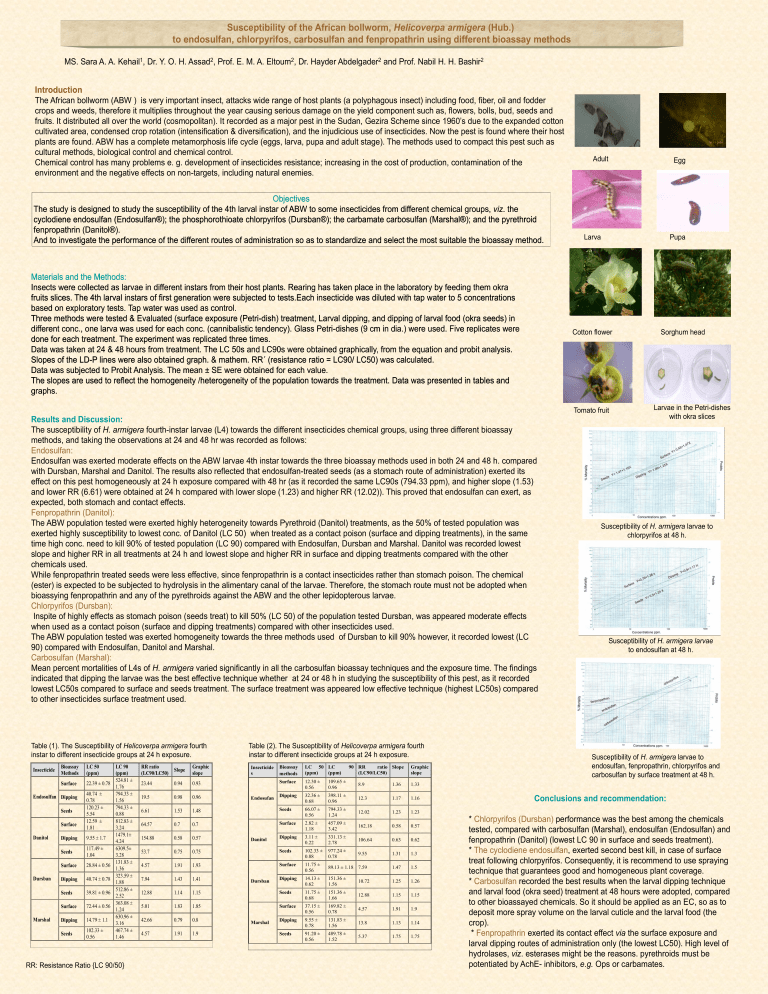
Susceptibility of the African bollworm, Helicoverpa armigera (Hub.) to endosulfan, chlorpyrifos, carbosulfan and fenpropathrin using different bioassay methods
MS. Sara A. A. Kehail 1 , Dr. Y. O. H. Assad 2 , Prof. E. M. A. Eltoum 2 , Dr. Hayder Abdelgader 2 and Prof. Nabil H. H. Bashir 2
Introduction
The African bollworm (ABW ) is very important insect, attacks wide range of host plants (a polyphagous insect) including food, fiber, oil and fodder crops and weeds, therefore it multiplies throughout the year causing serious damage on the yield component such as, flowers, bolls, bud, seeds and fruits. It distributed all over the world (cosmopolitan). It recorded as a major pest in the Sudan, Gezira Scheme since 1960 ’s due to the expanded cotton cultivated area, condensed crop rotation (intensification & diversification), and the injudicious use of insecticides. Now the pest is found where their host plants are found. ABW has a complete metamorphosis life cycle (eggs, larva, pupa and adult stage). The methods used to compact this pest such as cultural methods, biological control and chemical control.
Chemical control has many problems e. g. development of insecticides resistance; increasing in the cost of production, contamination of the environment and the negative effects on non-targets, including natural enemies.
Objectives
The study is designed to study the susceptibility of the 4th larval instar of ABW to some insecticides from different chemical groups,
viz
. the cyclodiene endosulfan (Endosulfan®); the phosphorothioate chlorpyrifos (Dursban®); the carbamate carbosulfan (Marshal®); and the pyrethroid fenpropathrin (Danitol®).
And to investigate the performance of the different routes of administration so as to standardize and select the most suitable the bioassay method.
Adult
Larva
Materials and the Methods:
Insects were collected as larvae in different instars from their host plants. Rearing has taken place in the laboratory by feeding them okra fruits slices. The 4th larval instars of first generation were subjected to tests.Each insecticide was diluted with tap water to 5 concentrations based on exploratory tests. Tap water was used as control.
Three methods were tested & Evaluated (surface exposure (Petri-dish) treatment, Larval dipping, and dipping of larval food (okra seeds) in different conc., one larva was used for each conc. (cannibalistic tendency). Glass Petri-dishes (9 cm in dia.) were used. Five replicates were done for each treatment. The experiment was replicated three times.
Data was taken at 24 & 48 hours from treatment. The LC 50s and LC90s were obtained graphically, from the equation and probit analysis.
Slopes of the LD-P lines were also obtained graph. & mathem. RR ´ (resistance ratio = LC90/ LC50) was calculated.
Data was subjected to Probit Analysis. The mean ± SE were obtained for each value.
Cotton flower
Tomato fruit
Results and Discussion:
The susceptibility of
H. armigera
fourth-instar larvae (L4) towards the different insecticides chemical groups, using three different bioassay methods, and taking the observations at 24 and 48 hr was recorded as follows:
Endosulfan:
Endosulfan was exerted moderate effects on the ABW larvae 4th instar towards the three bioassay methods used in both 24 and 48 h. compared with Dursban, Marshal and Danitol. The results also reflected that endosulfan-treated seeds (as a stomach route of administration) exerted its effect on this pest homogeneously at 24 h exposure compared with 48 hr (as it recorded the same LC90s (794.33 ppm), and higher slope (1.53) and lower RR (6.61) were obtained at 24 h compared with lower slope (1.23) and higher RR (12.02)). This proved that endosulfan can exert, as expected, both stomach and contact effects.
Fenpropathrin (Danitol):
The ABW population tested were exerted highly heterogeneity towards Pyrethroid (Danitol) treatments, as the 50% of tested population was exerted highly susceptibility to lowest conc. of Danitol (LC 50) when treated as a contact poison (surface and dipping treatments), in the same time high conc. need to kill 90% of tested population (LC 90) compared with Endosulfan, Dursban and Marshal. Danitol was recorded lowest slope and higher RR in all treatments at 24 h and lowest slope and higher RR in surface and dipping treatments compared with the other chemicals used.
While fenpropathrin treated seeds were less effective, since fenpropathrin is a contact insecticides rather than stomach poison. The chemical
(ester) is expected to be subjected to hydrolysis in the alimentary canal of the larvae. Therefore, the stomach route must not be adopted when bioassying fenpropathrin and any of the pyrethroids against the ABW and the other lepidopterous larvae.
Chlorpyrifos (Dursban):
Inspite of highly effects as stomach poison (seeds treat) to kill 50% (LC 50) of the population tested Dursban, was appeared moderate effects when used as a contact poison (surface and dipping treatments) compared with other insecticides used.
The ABW population tested was exerted homogeneity towards the three methods used of Dursban to kill 90% however, it recorded lowest (LC
90) compared with Endosulfan, Danitol and Marshal.
Carbosulfan (Marshal):
Mean percent mortalities of L4s of
H. armigera
varied significantly in all the carbosulfan bioassay techniques and the exposure time. The findings indicated that dipping the larvae was the best effective technique whether at 24 or 48 h in studying the susceptibility of this pest, as it recorded lowest LC50s compared to surface and seeds treatment. The surface treatment was appeared low effective technique (highest LC50s) compared to other insecticides surface treatment used.
Egg
Pupa
Sorghum head
Larvae in the Petri-dishes with okra slices
Susceptibility of H. armigera larvae to chlorpyrifos at 48 h.
Susceptibility of H. armigera larvae to endosulfan at 48 h.
Table (1). The Susceptibility of Helicoverpa armigera fourth instar to different insecticide groups at 24 h exposure.
Insecticide
Endosulfan
Danitol
Dursban
Marshal
Bioassay
Methods
Surface
22.39 ± 0.78
Dipping
Seeds
Surface
Dipping
Seeds
Seeds
Dipping
Seeds
LC 50
(ppm)
40.74 ±
0.78
120.23 ±
5.54
12.59 ±
1.81
9.55 ± 1.7
117.49 ±
1.04
Surface
28.84 ± 0.56
Dipping
40.74 ± 0.78
39.81 ± 0.96
Surface
72.44 ± 0.56
14.79 ± 1.1
102.33 ±
0.56
LC 90
(ppm)
524.81 ±
1.76
794.33 ±
1.56
794.33 ±
0.88
812.83 ±
3.24
1479.1±
4.24
6309.5±
3.28
131.83 ±
1.36
323.59 ±
1.88
512.86 ±
2.52
363.08 ±
1.24
630.96 ±
3.16
467.74 ±
1.46
RR ratio
(LC90/LC50)
23.44
Slope
Graphic slope
0.94 0.93
19.5
6.61
64.57
154.88
53.7
4.57
7.94
12.88
5.01
42.66
4.57
0.98 0.96
1.53 1.48
0.7 0.7
0.58 0.57
0.75 0.75
1.91 1.93
1.43 1.41
1.14 1.15
1.83 1.85
0.79 0.8
1.91 1.9
RR: Resistance Ratio {LC 90/50}
Table (2). The Susceptibility of Helicoverpa armigera fourth instar to different insecticide groups at 24 h exposure.
Insecticide s
Endosufan
Danitol
Dursban
Marshal
Bioassay methods
LC
(ppm)
50
Surface 12.30 ±
0.56
Dipping 32.36 ±
0.68
LC
(ppm)
109.65 ±
0.96
398.11 ±
0.96
90 RR ratio
(LC90/LC50)
Slope Graphic slope
8.9
12.3
1.36
1.17
1.33
1.16
Seeds 66.07 ±
0.56
Surface 2.82 ±
1.18
Dipping 3.11 ±
0.22
794.33 ±
1.24
457.09 ±
3.42
331.13 ±
2.78
12.02
162.18
106.64
1.23
0.58
0.63
1.23
0.57
0.62
977.24 ±
0.78
9.55 1.31 1.3
Seeds 102.33 ±
0.88
Surface 11.75 ±
0.56
Dipping 14.13 ±
0.62
Seeds 11.75 ±
0.68
Surface 37.15 ±
0.56
Dipping 9.55 ±
0.78
Seeds 91.20 ±
0.56
89.13 ± 1.18 7.59
151.36 ±
1.56
151.36 ±
1.66
169.82 ±
0.78
131.83 ±
1.56
489.78 ±
1.52
10.72
12.88
4.57
13.8
5.37
1.47
1.25
1.15
1.91
1.13
1.75
1.5
1.26
1.15
1.9
1.14
1.75
Susceptibility of H. armigera larvae to endosulfan, fenpropathrin, chlorpyrifos and carbosulfan by surface treatment at 48 h.
Conclusions and recommendation:
*
Chlorpyrifos (Dursban)
performance was the best among the chemicals tested, compared with carbosulfan (Marshal), endosulfan (Endosulfan) and fenpropathrin (Danitol) (lowest LC 90 in surface and seeds treatment).
*
The cyclodiene endosulfan
, exerted second best kill, in case of surface treat following chlorpyrifos. Consequently, it is recommend to use spraying technique that guarantees good and homogeneous plant coverage.
*
Carbosulfan
recorded the best results when the larval dipping technique and larval food (okra seed) treatment at 48 hours were adopted, compared to other bioassayed chemicals. So it should be applied as an EC, so as to deposit more spray volume on the larval cuticle and the larval food (the crop).
*
Fenpropathrin
exerted its contact effect
via
the surface exposure and larval dipping routes of administration only (the lowest LC50). High level of hydrolases,
viz
. esterases might be the reasons. pyrethroids must be potentiated by AchE- inhibitors,
e.g.
Ops or carbamates.

